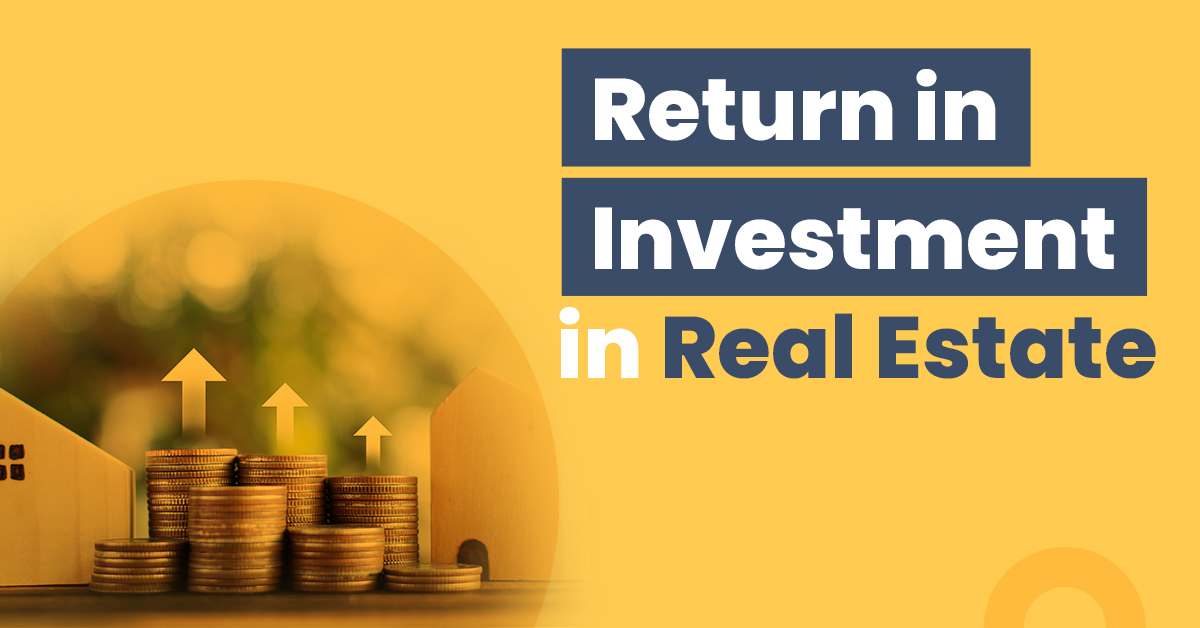How to Find Your Return on Investment in Real Estate?


The main objective of real estate investment is to enhance your wealth. Hence, you need to invest in a property that can help you generate healthy cash-flows and comparatively higher returns . However, going for the right property for investment can be quite a challenging task.
Most potential investors in real estate use return on investment (ROI) as a barometer to choose the right real estate property for investment. Read on to learn more about the methods of calculating ROI.
How to Calculate ROI in Real Estate?
ROI is the amount of profit as a percentage of the cost you make on an investment.
For example:
Suppose you have purchased a property of ₹ 1,00,000 and sold it for ₹ 1,50,000,
The profit generated on the sale transaction would be ₹ (1,50,000 – 1,00,000)= ₹ 50,000.
Since the profit is equal to half of the purchase price, your ROI will be 50%.
In reality, calculating ROI on real estate is slightly more complex. You will need to consider different variables that increase over time, such as repair and maintenance charges. For mathematical calculation, there are two key methods by which you can compute ROI. They are the Cost Method and the Out-of-pocket Method.
Mentioned below are examples of these two methods. Remember that these methods do not take rental income or property taxes into consideration.
- Cost Method
The cost method is applicable for properties purchased entirely with your own funds without taking any loan. Calculating ROI using this method is straightforward as you do not need to consider any interest payments associated with loans.
The ROI is calculated by dividing the Net Operating Income (NOI) by the total investment. NOI refers to the total income generated from an asset. In other words, it is equal to the difference between an investor’s income and their expenses, insurance, depreciation, etc., during a financial year.
For example:
Suppose you have purchased a property for ₹ 1,50,000. You have incurred maintenance charges of ₹ 50,000 in aggregate. The property sold for ₹ 2,50,000.
ROI = [{2,50,000 – (1,50,000 + 50,000)} / 2,00,000] X 100% = 25%
- Out-of-Pocket Method
Potential real estate investors prefer the Out-of-Pocket Method since it is a more practical approach to calculating ROI. Moreover, this method is also applicable in the case of loan-financed transactions.
For example:
Suppose you have purchased a property by taking a loan. The cash expended by you is:
(A) A down payment of ₹ 40,000; and
(B) Property renovated costs ₹ 60,000
Total cash expended (A+B) = ₹ 1,00,000
Now, if the selling value of your property is ₹ 2,50,000,
ROI = [(2,50,000 – 1,00,000) / 2,50,000] X 100% = 60%
Importance of ROI in Real Estate
Basically, ROI determines the amount of profit as a percentage of the real estate investment. The importance of ROI is mentioned below:
- It is an Indicator of the Earning Potential of an Investment
A higher ROI indicates greater returns. While a positive ROI indicates a profit, a negative value will indicate a loss. Thus, you need to filter out properties with negative ROI values.
- Helps Compare the Efficiencies of Different Investments
ROI differs from one property to another. This is because factors like market value and location can influence gains. It also helps you identify the nature of properties that are in demand and the geographical locations that generate high returns. It makes you an informed investor and helps you decide on the investment when you have multiple options.
What Is a Good ROI?
The ‘good’ in the context of ROI is subjective and can vary from one investor to another. The meaning of the ‘good’ eventually boils down to the risk appetite of the investor. In real estate, a good ROI is not immune from risks. At the same time, if you take more risks, you can expect a better ROI.
Some of the factors that attract investors towards real estate investments are:
- No Need for Physical Assets
To make real estate investing fruitful, many investors intend for returns that either equal or surpass the value of average returns on a major stock market index.
However, you do not need to purchase any physical assets to invest in real estate. Real estate investment trusts offer physical asset-like returns without the need to own or manage any physical property. However, REITs are comparatively more volatile than physical property.
- House Index Price
Over the past few years, the ROI on real estate has been following an unsteady trend. As per the House Price Index released by the Reserve Bank of India in the fourth quarter of the financial year 2021-2022, cities such as Kolkata, Chennai and Kanpur witnessed high growth in prices of residential house properties, indicating their attractiveness as real estate investment destinations.
- Range of ROI
ROI for commercial property should ideally range between 6% and 10%, i.e., higher than the ROI range of 3% to 5% for residential property. This is because of the complications associated with purchasing and selling commercial property in India. These are the overall prevailing trends of ROIs of rental real estate investments that vary with location.
Final Word
Last but not the least, for first-time investors, taking guidance from organisations can help to determine the most rewarding mode of investment. Understanding the above methods of calculating ROI should help you in efficient decision-making before choosing a property.
Frequently Asked Questions
What is a Real Estate ROI Calculator?
An Investment Property ROI Calculator or Real Estate ROI Calculator is a tool that provides reliable and prompt ROI calculations to investors by using accurate real estate data. It helps you to make sensible decisions on real estate investment.
What are the steps to calculate the ROI of rental property?
There are three simple steps by which you can compute the ROI of rental property:
Step 1: Note down your rental income
Step 2: Calculate the expenses, like the cost of renovation, maintenance, etc.
Step 3: Determine the ROI using the two methods mentioned above



